The 1955 Hudson Italia
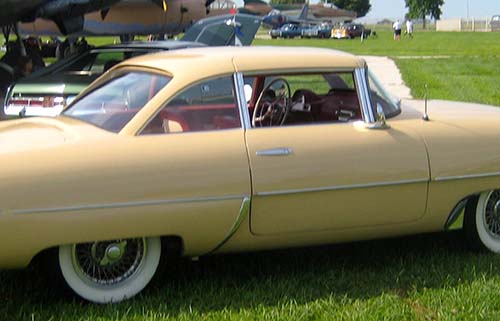
(1955 Hudson Italia at the Bill Reddig AMC Show at Grissom Aeroplex, Peru, Indiana on 08 August 2015. All photos by Socotra).
We got the fever at the car show. We always do, and leave while searching eBay motors for the perfect AMX hot rod, or a curious model Nash or Rambler Ambassador we remember from our youth. We grew up in an American Motors family with an undeniable chip on our shoulders. The fever normally passes within a couple days, but I have been known to make major life decisions before the fever breaks, and have come to terms with the phenomenon.
My brother and I were doing the first circuit of the Patriot Path, the concrete walkway that leads around the perimeter of the Grissom Aeroplex Aviation Museum near Peru, Indiana. I was lost in the airplanes and the cars parked under the wings, their proud owners seated in lawn chairs in the shade to stay cool against the rising humidity.
We rounded the C-117 Flying Boxcar and there it was. At the Rambler Rally, no less. It was a 1955 Hudson Italia, best example I have ever seen.
Let me give you some background about why a Hudson was here in the soybean fields of north central Indiana with the other rolling exemplars of American Motors iron:
Back in the car-crazy 1950s, Chrysler’s relationship with Italian design firm Ghia brought it a fair amount of time in the spotlight, a fact that did not go unnoticed by rival automaker Hudson. Fresh from the success of the Hudson Hornet in NASCAR, and looking for a way to market its new-for-1953 Jet compact, Hudson contracted with Italy’s Carrozzeria Touring on a Jet-based grand tourer, ultimately called the Italia.
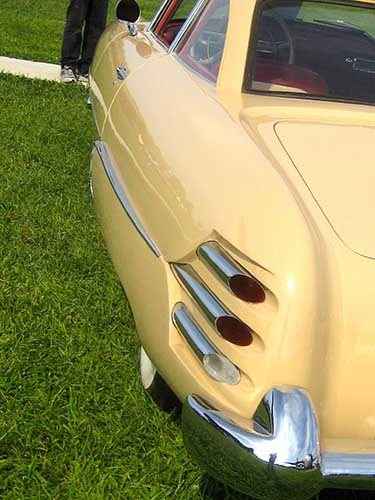
Counting the initial prototype, 26 were ultimately built.
The Hudson Italia was designed by Frank Spring, Hudson’s chief stylist, and Carlo Felice Bianchi Anderloni, his counterpart at Carrozzeria Touring. The Italia project was a consolation prize for Spring; his initial design for the Hudson Jet was so radically altered by the time the car hit production that Spring threatened to quit. To pacify him, Hudson management dangled the carrot of a concept sports car, something that Spring had long pestered the company’s management to build.
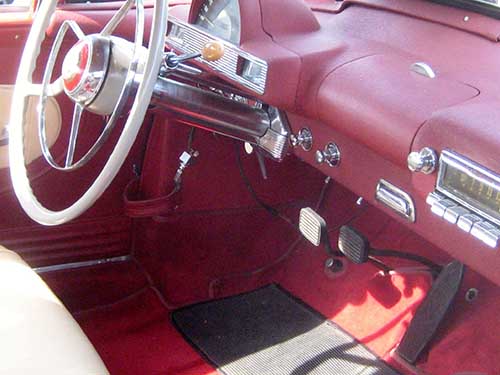
Designing an all-new model from the ground up was deemed cost-prohibitive, so it was Spring who made the initial contact with Touring. Production Hudson Jets were shipped to Touring in Milan, where the steel body was replaced with a superleggera body of hand-formed aluminum over a frame of thin-wall steel tubing. To call the design radical is a bit of an understatement, and the Italia sported triangular fender vents above the front wheels (presumably to aid in brake cooling, though these vents were not ducted), triangular bumper adornment, a wrap-around windshield and faux “exhausts” in the rear fenders that held tail lamps, directional and stop lamps.
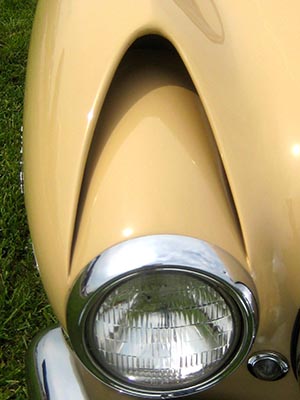
Inside, the Italia’s most unique feature was its two-passenger Mid-Century Modern seating. Each front bucket utilized a relatively conventional seat bottom, coupled with a twin-cushion upper that used foams of different density in each pad for added comfort. The gap between the cushions was intentional, and allowed the seats to “breathe” for added passenger comfort. One departure from convention was the use of leather seat belts, which were optimistically mounted to the seats themselves instead of a stronger and more rigid structure.
Though the Italia presented a more sporting appearance than the Jet, it was offered only with that model’s 202-cu.in. L-head six-cylinder engine, topped by a two-barrel Carter carburetor and rated at 114 horsepower. The sole transmission offering was a column-mounted three speed, but despite this, Hudson reportedly had plans to run the car in the touring car class at the La Carrera Panamericana. Doing so would require a run of 25 cars to qualify as a production vehicle, so Hudson contracted with Touring for an additional 25 cars after the initial prototype was completed.
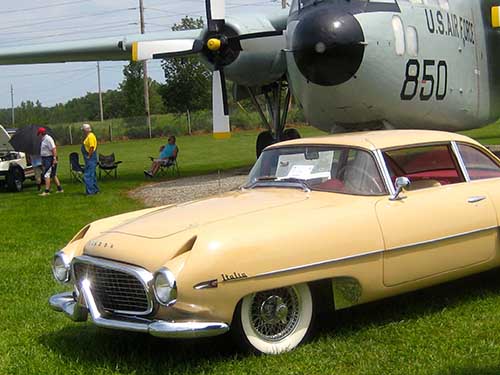
The Italia proved to be a tough sell, and not just because of its unconventional styling.
Despite cheaper labor, the expense of building the car in Italy raised the manufacturing cost, prompting Hudson to slap an F.O.B. Detroit dealer price of $4,800 on the coupe. In 1955, that was nearly double the retail price of a Ford Thunderbird, $1,866 more than a Chevrolet Corvette and $1,132 more than a Kaiser Darrin. In fact, it was even $495 more than a Cadillac Coupe de Ville, limiting the Italia’s appeal to a select group of well-heeled buyers. It is reported that just 19 Hudson dealers agreed to purchase Italias, leading to some confusion on the actual number built, shipped or sold in North America.
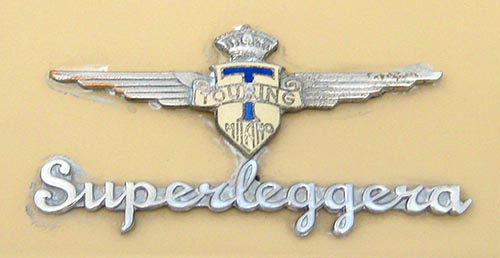
When American Motors merged with Hudson in 1954, the program became redundant with the Nash Healy exoticar featuring a big Detroit V-8 engine married to an English sports body, and American Motors pulled the plug on the Italia. In a fit of pique, Touring refused to manufacture or distribute spare parts, leaving potential Italia buyers to source comparable replacements on their own in the event of body damage.
As offered at a recent auction, a beat up Italia without engine or transmission went on the block with an estimated a selling price between $100,000 and $125,000 at Pebble Beach.
This one of the original 26 is a gem. Rambler owners are not all crazy, you know?
Of course, it does help if you are.
Copyright 2015 Vic Socotra
www.vicsocotra.com
Twitter: @jayare303
